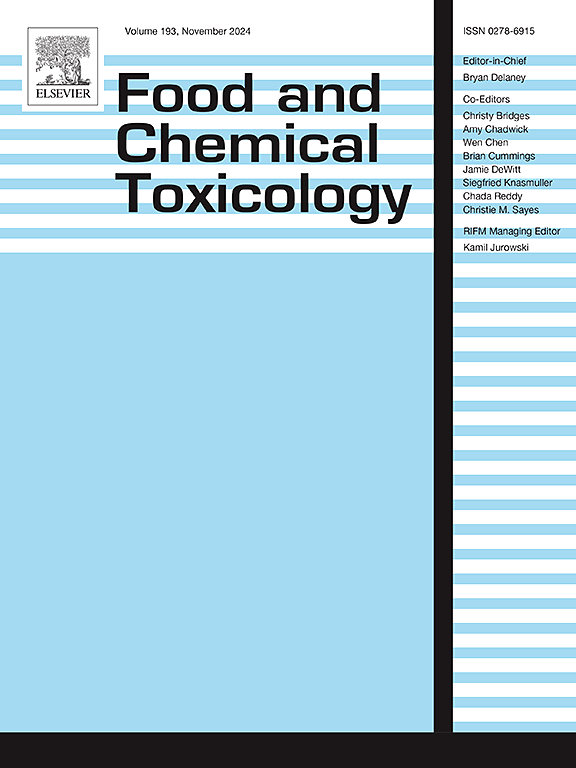丙烯酰胺生物标志物与生殖寿命的关系:美国妇女的横断面研究
IF 3.9
3区 医学
Q2 FOOD SCIENCE & TECHNOLOGY
引用次数: 0
摘要
丙烯酰胺(AA)是一种潜在的致癌物质,主要存在于富含碳水化合物的热加工食品和香烟烟雾中,它会形成丙烯酰胺-血红蛋白加合物(HbAA)及其代谢产物缩水甘油酰胺-血红蛋白加合物(HbGA)。女性生殖寿命(从月经初潮到更年期)是女性健康管理和疾病预防的关键。美国女性的生育寿命发生了变化,但缺乏对其原因的流行病学研究。这项横断面研究包括1275名来自美国国家健康与营养检查调查四个周期的自然绝经后妇女,平均年龄为61±12岁。我们使用线性回归、限制性三次样条(RCS)模型和阈值效应分析来检验HbAA、HbGA、HbGA/HbAA与女性生殖寿命之间的关系。结果表明,HbAA和HbGA水平低于36.6和44.7 pmol/gHb时,与生殖寿命无显著相关性,高于36.6和44.7 pmol/gHb时,与生殖寿命负相关增强。在对所有协变量进行调整后,HbAA和HbGA每增加2.7倍(1 ln单位)分别与生殖寿命减少1.4年(P = 0.003)和2年(P = 0.007)相关。HbAA和HbGA水平升高会缩短生殖寿命,而HbGA/HbAA无显著相关性。临床试验不适用。本文章由计算机程序翻译,如有差异,请以英文原文为准。
Associations of acrylamide biomarkers with reproductive lifespan: A cross-sectional study in U.S. women
Acrylamide (AA), a potential carcinogen mainly present in thermally processed carbohydrate-rich foods, and cigarette smoke, forms acrylamide-hemoglobin adducts (HbAA) and its metabolite glycidamide-hemoglobin adducts (HbGA). Female reproductive lifespan (from menarche to menopause) is the key to women's health management and disease prevention. The reproductive lifespan of US women has shifted, but epidemiological research on its causes is lacking. This cross-sectional study included 1275 naturally postmenopausal women from four cycles of the US National Health and Nutrition Examination Survey, with a mean age of 61 ± 12 years. We examined the associations between HbAA, HbGA, the ratio of HbGA to HbAA (HbGA/HbAA) with female reproductive lifespan using linear regressions, restricted cubic splines (RCS) models, and threshold effect analyses. Results showed that HbAA and HbGA levels below 36.6 and 44.7 pmol/gHb showed no significant association with reproductive lifespan, but above these levels, the negative associations with reproductive lifespan strengthened. After adjusting for all covariates, each 2.7 - fold increase (one ln unit) in HbAA and HbGA was associated with a reduction in reproductive lifespan of 1.4 years (P = 0.003) and 2 years (P = 0.007) respectively. Higher levels of HbAA and HbGA shorten reproductive lifespan, while HbGA/HbAA showed no significant association.
Clinical trial
not applicable.
求助全文
通过发布文献求助,成功后即可免费获取论文全文。
去求助
来源期刊

Food and Chemical Toxicology
工程技术-毒理学
CiteScore
10.90
自引率
4.70%
发文量
651
审稿时长
31 days
期刊介绍:
Food and Chemical Toxicology (FCT), an internationally renowned journal, that publishes original research articles and reviews on toxic effects, in animals and humans, of natural or synthetic chemicals occurring in the human environment with particular emphasis on food, drugs, and chemicals, including agricultural and industrial safety, and consumer product safety. Areas such as safety evaluation of novel foods and ingredients, biotechnologically-derived products, and nanomaterials are included in the scope of the journal. FCT also encourages submission of papers on inter-relationships between nutrition and toxicology and on in vitro techniques, particularly those fostering the 3 Rs.
The principal aim of the journal is to publish high impact, scholarly work and to serve as a multidisciplinary forum for research in toxicology. Papers submitted will be judged on the basis of scientific originality and contribution to the field, quality and subject matter. Studies should address at least one of the following:
-Adverse physiological/biochemical, or pathological changes induced by specific defined substances
-New techniques for assessing potential toxicity, including molecular biology
-Mechanisms underlying toxic phenomena
-Toxicological examinations of specific chemicals or consumer products, both those showing adverse effects and those demonstrating safety, that meet current standards of scientific acceptability.
Authors must clearly and briefly identify what novel toxic effect (s) or toxic mechanism (s) of the chemical are being reported and what their significance is in the abstract. Furthermore, sufficient doses should be included in order to provide information on NOAEL/LOAEL values.
 求助内容:
求助内容: 应助结果提醒方式:
应助结果提醒方式:


